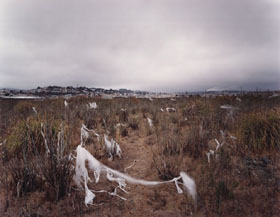| Stanford Art Spaces |
|---|
| July 18, 2003 to September 11, 2003, Stanford Art Spaces features an exhibit by five artists: |
|---|
|
Julie Dummermuth Paintings |
Eirik Johnson Photography |
Kathleen J. Li Paintings |
Maria Park Mixed Media |
Maria Vasconcelos Paintings |
 It's a Good Thing © 2003 |
 Untitled © 2003 |
 Untitled © 2003 |
 Metaverse © 2003 |
 Untitled © 2003 |
| This exhibit is located on the Stanford University campus in two buildings: the Center for Integrated Systems (CIS) and Terman Engineering Center. It is open 8:30 am to 5 pm, Monday through Friday. A directory is available at the CIS reception desk. |
|---|
|
Most works are for sale directly from the artists. For information, contact M. Grossman, Curator, at (650) 725-3622 or marigros@stanford.edu |
| Julie Dummermuth |
|---|

|
In today’s society we are surrounded by superficial decorations and meretricious performances of etiquette suggesting lives filled with importance. The visual rhetoric of hallmark celebrations insinuate all will be perfect when the appropriate festoons and somersaults are in attendance. These spectacles of artifice consume us and are certainly, simultaneously, absurd. Mining a “loving and laughing-at-it” relationship with artificial sweetness I magnify the exuberance of holiday entertaining (used for those “calendar markers”) to celebrate a hurray-for-holidays nostalgia and to manifest a candyland of sumptuous synthetic absurdity mocking the inherent lack of meaning from such excess. Painting alchemies of lush ornamental fantasies and garnishing them with glittering gems, gold leaf and glitter I hope to seduce viewers into that empty seasonal sweetness prevalent in these pleasantries of prettiness. After all no matter how nugatory such clutter, nor how much disdain we impart towards it, its importance does command a niche in our lives. |
| Eirik Johnson |
|---|

|
“ Stories about places are makeshift things. They are composed of the world’s debris” –Michel de Certeau Sometimes we drift away from our daily path, wandering past a fence and into an empty lot or beyond and into the woods. Sometimes we break from the normal routine and indulge in our desire to explore what surrounds us. It is in the overlooked backwaters of an urban environment that one begins to find strange and wonderful meaning in the most basic things. I am interested in looking at the edges of the urban environment through an inquisitive response and interaction with what I discover in the area. The resulting photographs reflect a re-interpretation of the materials found at the site. Debris becomes a new vocabulary for creating peculiar relationships with the existing environment. These cast off materials mark the path for a new exploration of the areas that border our every day surroundings. |
| Kathleen J. Li |
|---|

|
Children’s stories cast a utopian view on human life by resolving narratives in the “happily ever after” manner. Growing up hearing these myths, one encounters the disparity in the way their discord manifests and lingers on in the real world. The safe and untainted world of childhood is open to corruption by the interference of harsh realism of growing up. The softly painted surface of the painting invites the viewer to approach the work, while slowly revealing unsettling forms within the play of silhouettes are contingent upon the viewer’s own projection onto the work. They can become harmless or as dangerous as the imagination allows. These paintings set up a condition allowing the viewer to construct one’s own narrative. |
| Maria Park |
|---|

|
Oh! The places you'll go |
|
The heavy weight of inertia dissipates as the landscapes stream past at
different speeds, revealing new models of refraction.
|
| Maria Vasconcelos |
|---|

|
The materiality of paint.
It roams about freely,
When does a wall stop being a wall? Moments of transformation.
Once a shape is removed from its original context
The search for experimental ways to apply paint… |
|
Most works are for sale directly from the artists. For information, contact M. Grossman, Curator, at (650) 725-3622 or marigros@stanford.edu |
| Go to top of this page | Return to SAS Schedule |
|---|